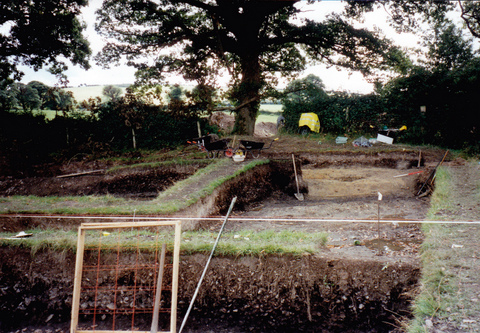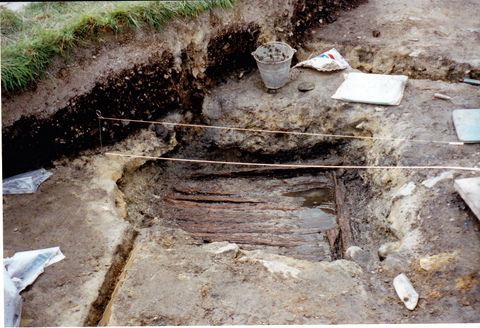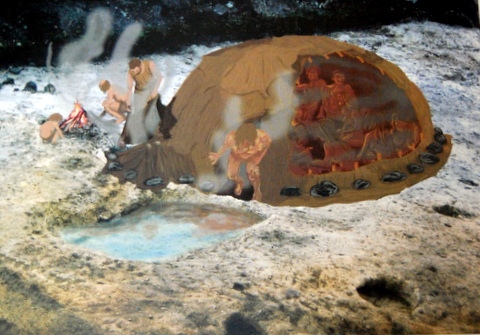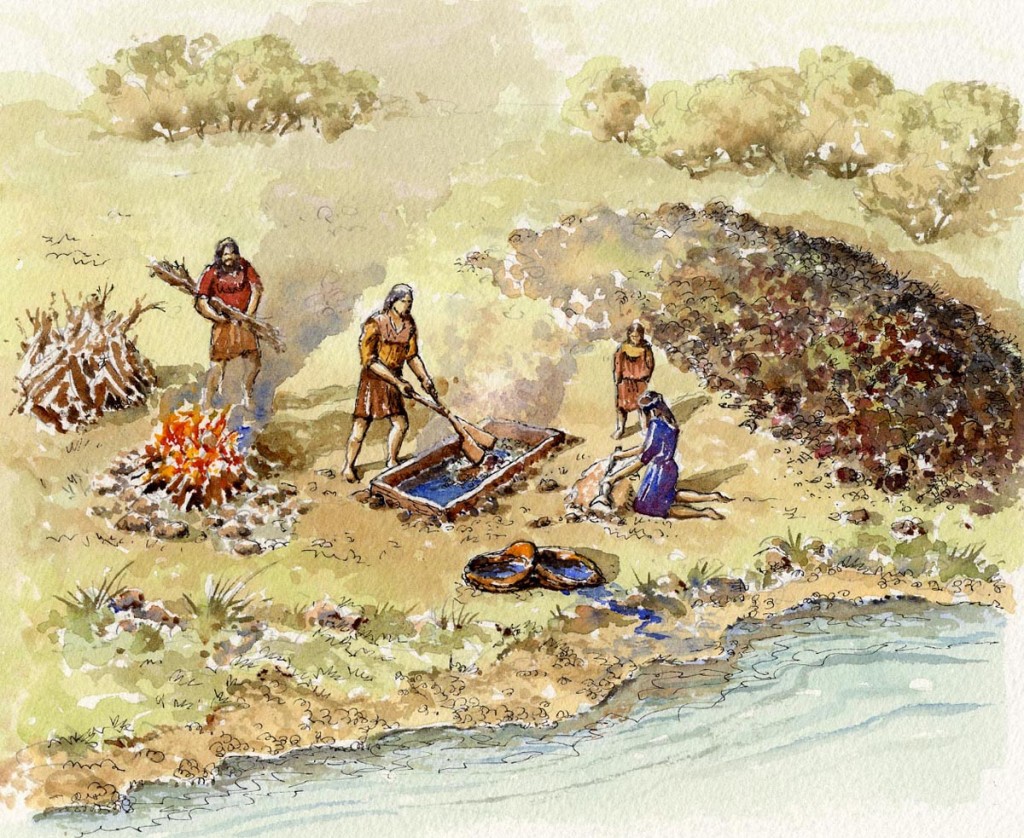
Burnt mounds are a type of archaeological site whose defining characteristic is large quantities of heat shattered stone. These sites commonly date to the Bronze Age, although examples from the Neolithic through to the medieval period are known. Burnt mounds are also known as fulacht fiadh and have been primarily interpreted as cooking places. The term fulacht fian is found in the early Irish literature from at least the 9th century AD (Waddell 1998, 174) and refers to open-air cooking places in which a water filled pit was made in which to cook meat. The early Irish literature also shows that the word fulacht is not only applied to a water filled pit for boiling meat but also to an outdoor cooking pit where meat was roasted on a spit or over an open fire (Kelly 1998, 337).
In the field extant burnt mounds are noted as low grassy mounds which can be circular or crescent shaped. Size varies from sites which are only a few metres in diameter to those which can be upwards of thirty metres. The usual location of burnt mounds is close to a water source, such as a stream or lake, or simply in low-lying boggy ground. Due to the extensive agricultural activity which much of Ireland has seen, burnt mounds are often ploughed-out and leave no trace on the ground surface. In this case if the land is topsoil stripped the remains of the burnt mound will be seen as a shallow deposit of heat shattered stones which lie within a charcoal rich black soil.

The general sequence of events observable at these sites is the digging of a pit or pits into the subsoil, which functioned as troughs for holding water, followed by the build up of heat shattered stones and the residues of fires. Sometimes hut sites were located beside the sites. Excavated troughs are generally found to be rectangular or sub-rectangular in shape. Some excavated troughs contained a timber lining to keep the sides from collapsing, or a clay lining, to keep the water in. A fire was set near to the trough upon which stone was heated and the heated stones were subsequently dropped into the water. The resultant boiling water was then used for a variety of purposes. Once the water heating process was complete the trough was cleaned out and the stones were cast aside giving rise to the characteristic shaped mounds present in today’s landscape. The stones did not always shatter in the process and could be re-used.
As well as the occurrence of troughs and deposits of burnt stone, burnt mounds have another common characteristic – the use of certain types of stone. In general sedimentary rocks such as sandstone are very common and experiments have shown that sandstone can be heated and cooled around five times before splitting into unusable fragments (Buckley 1990, 171).

The most common explanation for the function of burnt mound sites is as cooking sites, although a number of other theories have been postulated to explain the nature of these sites. It has been demonstrated that they could have been covered by light structures and used as saunas or sweathouses such as that at Rathpatrick, Co. Waterford (Eogan & Shee Twohig 2012, 179). Industrial uses such as the washing or dyeing of cloths and hides have been postulated (Waddell 1998, 177), and it has also been argued that they were used to brew beer (Quinn & Moore 2009). What is clear is that large quantities of hot or boiling water were produced and the sites often had long periods of use as attested by the large mounds of stone. The absence of animal bone does not preclude cooking activities as carcasses may have been prepared elsewhere and brought to the site and, once the meat was cooked it may have been taken elsewhere to be eaten. The damp soil conditions associated with burnt mounds do not generally favour the preservation of animal bone.

The alternative explanations of bathing and industrial activity (such as dyeing or metalworking) are often postulated on the basis of ethnographic parallels. Bathing is mentioned in several early Irish texts in conjunction with cooking perhaps suggesting that the sites were multifunctional.
Burnt mounds appear to have a long period of use in Ireland. Excavations at Clowanstown, Co. Meath, revealed the presence of five upstanding Neolithic burnt mounds (Archaeology Ireland, winter 2007, p.12), and examples are known from this period through to the medieval period, giving a span of use of some five thousand years.
Edit: For an excellent discussion on the dating of burnt mounds in the medieval period read “Medieval fulachtai fia in Ireland? An archaeological assessment” by Alan Hawkes, published in the latest edition of the Journal of Irish Archaeology. Hawkes concludes that it is unlikely that the burnt mound tradation continued into the medieval period
I’d like to thank Catherine McLoughlin for this excellent article on burnt mounds/fulacht fiadh. Catherine is joint owner of the well-known Wexford based archaeological company Stafford McLoughlin Ltd and she has over ten years experience as a licenced archaeologist. I hope you enjoy her guest blog post. Colm.
References
Archaeology Ireland. Wordwell, Dublin.
Buckley, V. 1990 Burnt Offerings. Wordwell, Dublin.
Hore, P.H. 1900-1911 History of the Town and County of Wexford. London.
Eogan, J., & Shee Twohig, E. 2012 Cois tSiuire – Nine Thousand years of Human Activity in the Lower Suir Valley. NRA Scheme Monographs 8, Dublin.
Kelly, F. 1998 Early Irish Farming. Dublin Institute for Advanced Studies.
Quinn, B., & Moore, D. 2009 ‘Fulacht fiadh’ and the beer experiment’ in Stanley et al (eds) Dining & Dwelling. NRA Monograph Series No. 6, 43-53, NRA, Dublin.
Waddell, J., 1998 The Prehistoric Archaeology of Ireland, Galway University Press.



Of all the concepts that exist within the Irish Archaeography the fulacht fiadh is the most dubious. Being aware that we cannot impose on the past the modes of today nonetheless neither can we dismiss it.
I have a George Foreman grill. I used it about ten time in total. Now there is nothing more simple as plugging the thing into the wall, letting it heat up, whacking whatever slice of meat onto it and closing the top. Except a frying pan.
Why for the love of god would you dig a hole. Fill it with water. Find the stones. Find the wood. Built the fire. Butcher the beast. Put the stones into the fire, thence to the hole filled with water. In with the meat. Now, since the time taken to cook the joints would require the repeated insertion of the stones. This would fill the pool with rocks long before the meat would be cooked. But why on earth would you not burn out the timber to embers rake it back then place the meat on the stone then rake the embers over the meat. Thereby removing about fifty different distinct stages.
As to the sweat lodge notion. Given the volume of stone, it would imply the thing would be on the go for donkeys years since you only need a few stones for lots of steam. But at least there is some sort of evidence.
For an excellent discussion on the dating of burnt mounds in the medieval period read “Medieval fulachtai fia in Ireland? An archaeological assessment” by Alan Hawkes, published in the latest edition of the Journal of Irish Archaeology. Hawkes concludes that it is unlikely that the burnt mound tradation continued into the medieval period.